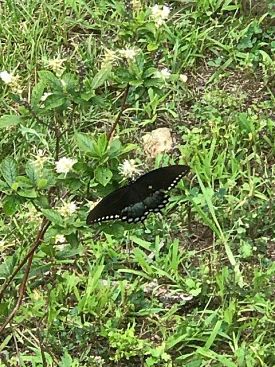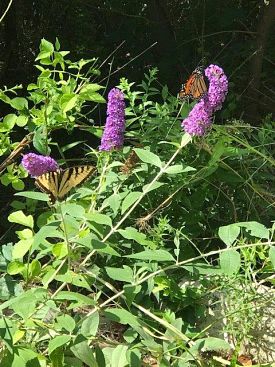Lloyd Center Buzzing With Insect Life
by Jamie Bogart, Lloyd Center Research Associate
As the summer season enters its home stretch, shorebirds, raptors, and waders are all on the move along the coastline, with recent tropical storm Henri only increasing sightings along churned up waters. Inland songbirds such as goldfinches from the forest and open landscape species such as an immature Horned Lark that passed through West Island beach and dunes areas recently, are also migrating along the shores. The lack of bird feeders due to avian disease concerns, hot weather, and woods being generally humid and buggy in August, has us tuned in to the shoreline for activities including nature viewing.
However, if one does find themselves on the interior landscape on a comfortable day, or along the beach with attention to the dune areas, an obscure taxonomic group, the insects, are quite abundant. Adult butterflies, moths, bees, and wasps, have left the larval stage and are nectaring at wild flora and planted flowers including those in butterfly gardens. On the Lloyd Center property, the Spicebush and Eastern Tiger Swallowtail butterflies are commonly seen in late summer at the edges of our woodlands, including at our butterfly gardens and in the vicinity of the parking lots. Part of the requirement of butterfly habitat is food plants for larval stages (caterpillars), with Spicebush feeding on the spicebush shrub and sassafras which is abundant on the property, and Tiger Swallowtail mainly on cherry and poplar trees. The Hummingbird Moth lives up to its name as it hovers over flowers such as butterfly bush nectaring mimicking the bird, and also feeds on cherry tree.
The July hatch of monarchs was robust with the species currently visiting our butterfly garden, mingling with other butterflies and moths. Renowned for their long migrations of 3,000 miles between Mexico and Canada in spring and fall, numbers are particularly high along the coast in late summer and early fall, when the Lloyd Center holds monarch tagging programs at Gooseberry Island. The monarchs are also known for the strikingly colored caterpillars found on their milkweed food plant.
During August, cicadas, large bugs with clear wings, emerge in sometimes immense numbers. Not to be confused with the periodical cicadas surfacing every 13-17 years, as occurred this year in the Mid-Atlantic region, our species emerges annually in August with calling males herding and producing a buzzing sound in the tree canopy. The “cicada killer” is a large wasp that builds large sandy burrows in the ground and has a particular liking for the bug. These burrows are abundant on the lawn near our new Welcome Center where there is a strip of mountain mint currently buzzing with bees and wasps of various species.
The Lloyd Center continues its insect work in a multi-state contract for sampling moths this season, focusing on habitats experiencing varying degrees of management and restoration to help recreate early successional habitats which are in decline. Read more about this work in the fall at the project’s conclusion, and in the meantime come and explore the diversity of bug life present at the Lloyd Center!





